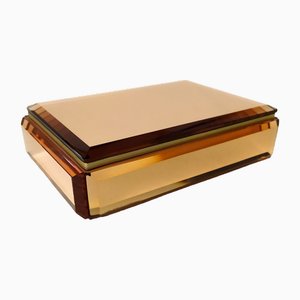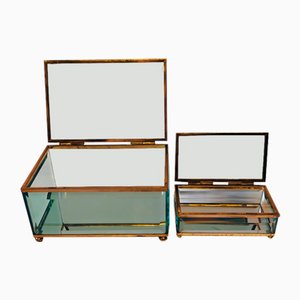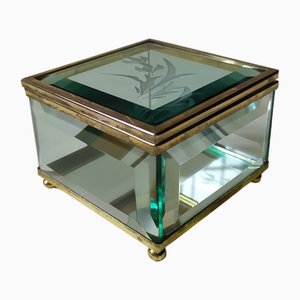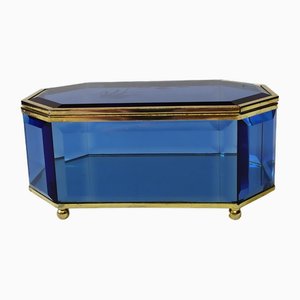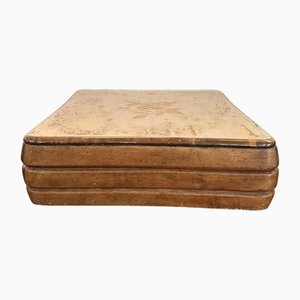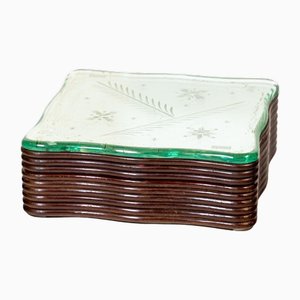
Luigi Fontana founded his eponymous plate glass manufacturing company in Milan in 1881. As he achieved increasing success in the construction sector—which attracted new investors, including the multinational Saint-Gobain glass company—Luigi Fontana & Partners opened outlets both nationally and abroad, becoming one of the largest glass manufacturers in Italy.
Between 1930 and 1932, hoping to make inroads in the art glass and décor sector, Fontana hired famed Italian architect-designer Gio Ponti (1891-1979)—then art director for the ceramics company Richard Ginori—to consult and create new designs for the domestic market, leading to Ponti’s now-iconic 0024 Pendant (1931) and Bilia Table Lamp (1931/32). By 1933, the collaboration gave rise to Fontana Arte, an artistic glass works division of Fontana’s company. The same year, Fontana Arte acquired Italian designer Pietro Chiesa’s (1892-1948) glass workshop, Bottega di Pietro Chiesa, and Ponti and Chiesa shared the role of art director for the expanded company. Soon they were garnering wide acclaim for a variety of sophisticated glass objects, encompassing stained glass, lighting, decorative mirrors, sculptural pieces, and even furniture made of glass, most of which were characterized by a purity of form remarkable for the time. Early successes included Chiesa’s Fontana Coffee Table (1932), Cartoccio Vase (1932), Luminator Floor Lamp (1933), and 006 Series (1933/37).
Throughout the 1940s and early 1950s, Fontana Arte developed few new products, relying instead on iterations of Chiesa’s designs from the 1930s. This creative conservatism stemmed from the devastation of the war years and the economic turmoil that immediately followed. A few private commissions from hotels, offices, and museums helped sustain the company until the postwar recovery took hold in Italy.
In 1954, French-born designer Max Ingrand (1908-1969) took the helm as artistic director and ushered in a new era of fashionableness and acclaim for Fontana Arte. From chandeliers, sconces, and lamps to furniture, mirrors, and decorative objects, the company’s prolific, sometimes bespoke, output during the postwar era earned it a reputation for glamour and au courant style. One piece from the ’50s that remains a bestseller today is Ingrand’s Fontana Table (1954). Notably, many pieces produced by Ingrand in collaboration with Pietro Raimondi (of whom little is published) in the ’50s and ’60s are now popular on the vintage market.
In 1967, two years before Ingrand’s untimely death, Ponti returned to Fontana Arte as art director. Although short lived, his second tenure produced two iconic collections, the Pirellina and Pirellone (1967).
As the ‘60s drew to a close, and throughout most of the 1970s, Fontana Arte lost cachet. In 1972, Saint-Gobain took direct ownership, and production and material quality declined. In 1979, however, Fontana Arte changed hands again to another group of shareholders represented by CEO Carlo Guglielmi. A new, successful phase was established when Guglielmi brought in Italian architect Gae Aulenti as Fontana Arte’s new art director. Standout pieces from this era include Aulenti’s Tavolo con Ruote Table (1980) and Aulenti and Piero Castiglioni’s Parola Table Lamp (1980).
In 1998, Fontana Arte was awarded the ADI Compasso d'Oro in recognition for its significant contribution to the Italian design legacy. Cementing its position at the forefront of technical expertise and design flair, Fontana Art combined with the Nice Group in 2012. Twenty-first-century collaborations with architects and designers include Steven Holl, David Chipperfield, Vico Magistretti, GamFratesi, Karim Rashid, Form Us with Love, and Harry & Camila. Works produced by Fontana Arte can be found in the permanent collections of the Museum of Modern Art (New York), Vitra Design Museum (Weil am Rhein), the Triennale di Milano, and more.
*All images courtesy of Fontana Arte

